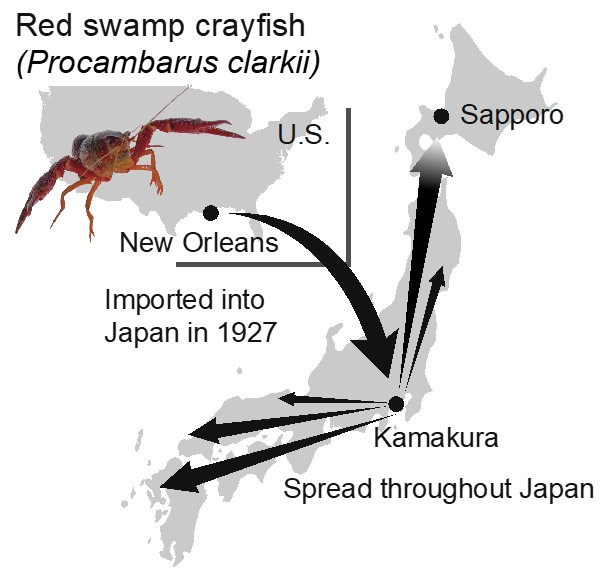Researchers from Japan have identified the molecular mechanisms that allow the red swamp crayfish to develop cold tolerance and, thus, colonize cold regions
The red swamp crayfish—found originally in tropical regions—has become a highly invasive species across the globe. Over the years, they have successfully colonized habitats much colder than their original habitats, but the factors determining their cold resistance have remained elusive. Recently, a group of researchers in Japan has discovered genes that may help the red swamp crayfish produce protective proteins and adapt to the cold.

Image title: The route of invasion of the red swamp crayfish in Japan
Image caption: The red swamp crayfish—originally imported from New Orleans, USA, to Kamakura, Japan, in 1927—spread throughout the Japanese archipelago except for Hokkaido, the northernmost island of Japan, over the years and became one of the most notorious non-native freshwater invertebrates by the 1950s. A recent study, however, reported the possibility that some populations settled in Sapporo City of central Hokkaido, where water temperatures become extremely low during the winter.
Image credits: Daiki Sato and Takashi Makino
License type: Original content
Owing to human activities and climate change, many animal species have invaded new habitats. Such biological invasion comes with devastating impacts on the local biodiversity and ecosystems. The red swamp crayfish—known to the scientific world as Procambarus clarkii (P. clarkii)— is no exception. P. clarkii is a freshwater crayfish native to the tropical regions of southern USA and northeastern Mexico. After their introduction to different parts of the world, they have become one of the most widespread and invasive animal species. They are known for their adaptability and aggressive behavior that ensure their survival in a wide range of environments, even in regions much colder than their original habitats.
Given that P. clarkii is typically limited to subtropical climates, researchers have long endeavored to find a few P. clarkii populations in the colder regions of Japan. In Hokkaido, the northernmost island of Japan, P. clarkii populations have been observed in a limited number of rivers and ponds where water from hot springs or sewage treatment plants flows in and contributes to high water temperatures throughout the year. A recent report, however, describes some populations settled in Sapporo City of central Hokkaido, where water temperatures become extremely low during the winter. A group of researchers from Japan, including Dr. Daiki Sato, Assistant Professor in the Graduate School of Science of Chiba University, and Professor Takashi Makino from Tohoku University sought to study the genetic changes that have allowed the crayfish to adapt to these cold environments. Their study was made available online on July 3, 2023, and will be published in Volume 26, Issue 8 of the journal iScience on August 18, 2023. Their article was additionally selected and included in the journal’s special issue, “Invasion Dynamics.”
Speaking about the motivations behind their study, Prof. Makino, who led the study, says, “Although the red swamp crayfish has been a well-known and notorious invasive species in Japan for quite some time, nobody has examined its genomic and transcriptomic characteristics that contribute to its invasiveness yet, thus motivating us to pursue this study. We feel our study has far-reaching ecological implications.”
Accordingly, the researchers studied P. clarkii from different populations in the newly colonized Japan and the originally inhabited USA. They compared differences in cold tolerance and related genetic characteristics among the samples. They also studied the effects of natural selection by comparing changes in gene sequences among the samples.
When asked about the main findings of the study, Dr. Sato, the first and co-corresponding author of the study, exclaims, “A population of red swamp crayfish in Sapporo, Japan may have acquired genetic changes that enhanced its cold tolerance. We have revealed the genes and genomic architecture possibly involved in the cold adaptation mechanism.”
The researchers found that different P. clarkii populations, even within Japan, responded differently to the cold: some showed no significant changes in gene expression over time, while others displayed noticeable differences between the beginning and the end of the experiment.
Notably, they discovered regulatory changes in a group of genes involved in developing the protective outer layer of P. clarkii, called the cuticle. They also found an increase in the production of peptidase inhibitors—proteins that prevent the enzymatic degradation of proteins in the body. These peptidase inhibitors play a role in preserving protective proteins from being cold-damaged, thus contributing to cold resistance in P. clarkii.
Further, the researchers also found that some of the studied genes had undergone significant levels of duplication that resulted in a large number of copies of the same genes within the genome. This duplication may have amplified the genes’ functional abilities in dealing with low temperatures.
These results provide valuable insights into the molecular mechanisms adopted by invasive species to develop cold resistance and survive in cold habitats. When used in the right context, these findings could have potential medical applications.
Overall, these findings significantly contribute to our understanding of invasive species, which may help us take measures to prevent their spread and, in turn, protect global biodiversity.
About Assistant Professor Daiki Sato
Dr. Daiki Sato is an assistant professor at the Institute for Advanced Academic Research/Graduate School of Science, Chiba University. He works to unravel the molecular mechanisms and ecological functions underlying behavioral diversity in animals. His research interests include evolutionary genomics and behavioral ecology. He is a member of the Society for Evolutionary Studies, Japan, and The Ecological Society of Japan.
Reference
Title of original paper: Genomic adaptive potential to cold environments in the invasive red swamp crayfish
Authors: Daiki X. Sato 1, 2, 3, Yuki Matsuda3, Nisikawa Usio4, Ryo Funayama5, Keiko Nakayama5, and Takashi Makino3
Affiliations:
- Institute for Advanced Academic Research, Chiba University
- Graduate School of Science, Chiba University
- Graduate School of Life Sciences, Tohoku University
- Institute of Nature and Environmental Technology, Kanazawa University
- Department of Cell Proliferation, United Center for Advanced Research and Translational Medicine, Graduate School of Medicine, Tohoku University
DOI: 10.1016/j.isci.2023.107267
Contact:
― Daiki X. Sato, Institute for Advanced Academic Research, Chiba University, Japan
Email: daikisato@chiba-u.jp
― Takashi Makino, Graduate School of Life Sciences, Tohoku University, Japan
Email: tamakino@tohoku.ac.jp
Public Relations Office, Chiba University
Address: 1-33 Yayoicho, Inage, Chiba 263-8522, Japan
Email: koho-press@chiba-u.jp
Recommend
-

What causes nations and regions to perceive the COVID-19 crisis differently?〜Insights from the Humanities and Social Sciences Needed for Disaster Management Research
2022.12.12
-

Unlocking the Enigma of Dark Matter: Gazing Beyond the Lens into the Universe
2023.06.09
-

Backing Revitalization in Rural Areas: Unearthing the Subtle Heart of the Community
2024.12.27


